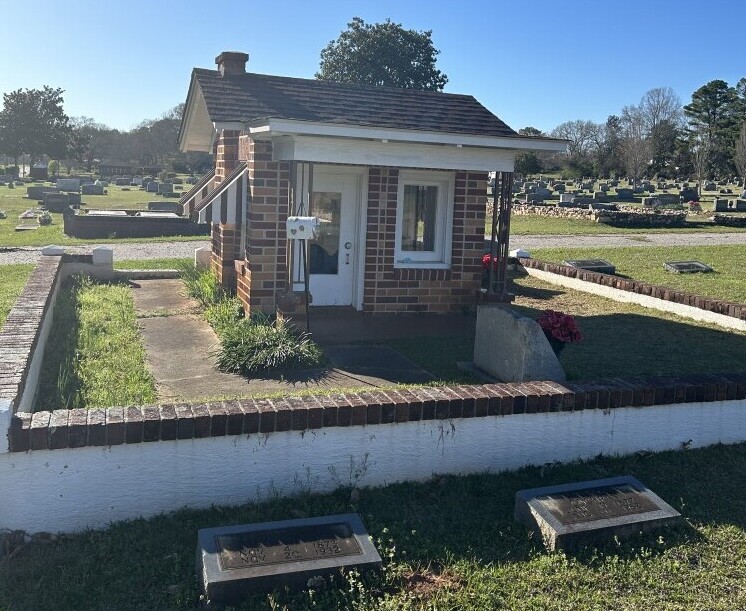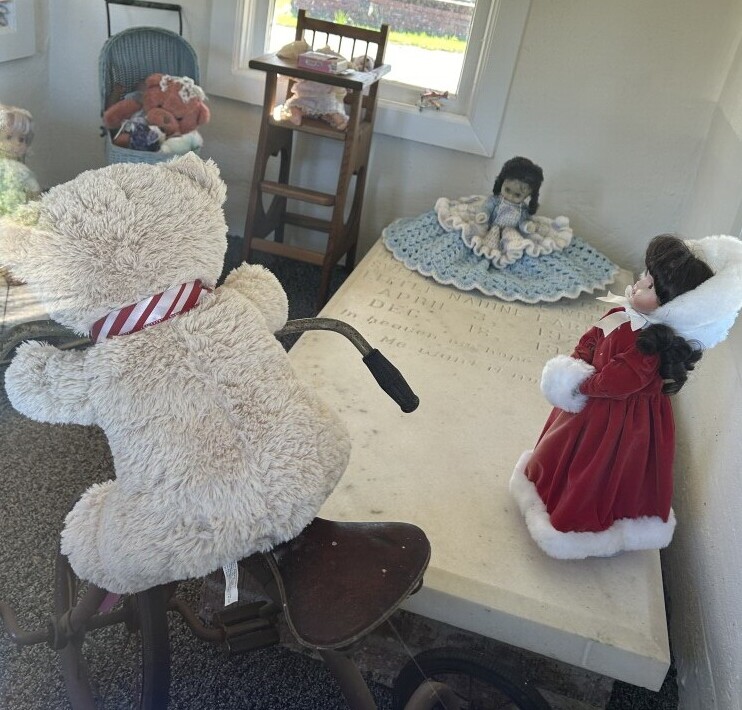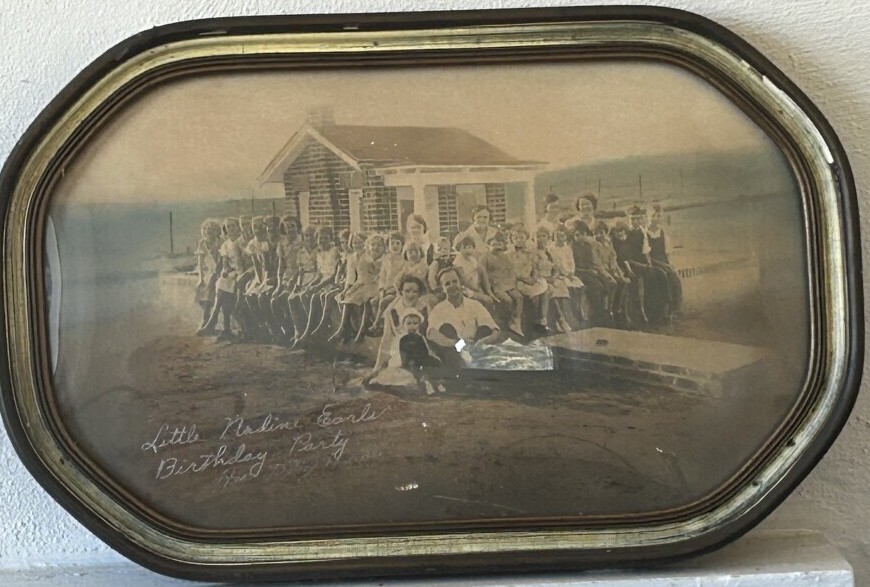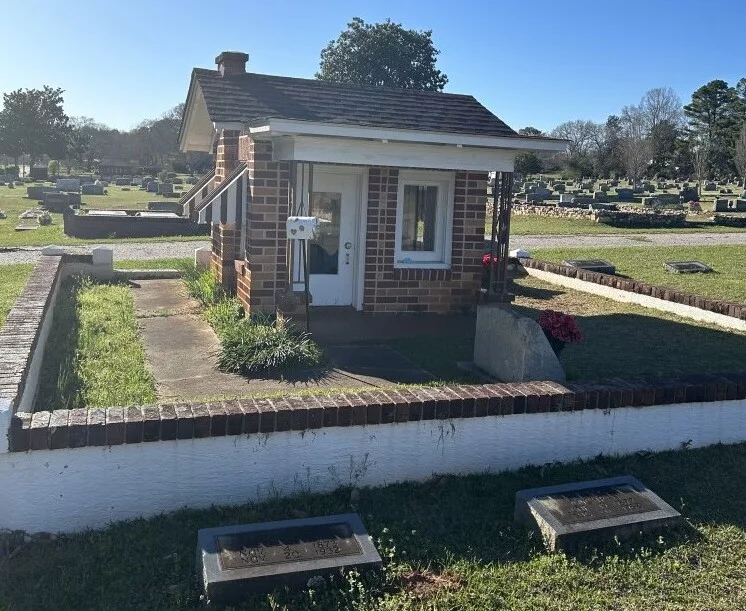If you’ve ever wandered into a cemetery expecting silence and stone, you might be surprised by the sound of your own heartbeat quickening. That’s how it felt the first time I stepped up to Little Nadine’s Playhouse Mausoleum in Lanett, Alabama. It looks like something lifted straight out of a childhood storybook: a tiny brick house, striped awnings, a little porch. But then you realize—it’s not a playhouse at all. It’s a grave.
And suddenly, you’re standing inside one of Alabama’s most unforgettable love stories.

Where You’ll Find Little Nadine’s Playhouse
Lanett sits on the Alabama–Georgia line, about 80 miles northeast of Montgomery and 90 miles southwest of Atlanta. Oakwood Cemetery, where Nadine rests, isn’t flashy or touristy. There are no big signs or kiosks. You just pull off South 8th Avenue, roll past quiet rows of markers, and then—like a child’s toy left in a grown-up world—you spot it.
The playhouse is small enough to look fragile but built solid from brick and mortar. A gabled roof. A chimney. Windows dressed in striped curtains. It’s cheerful and haunting all at once.
The Story Behind the Playhouse
In 1933, four-year-old Roselind Nadine Earles wanted one thing for Christmas: a playhouse her father had promised to build. But diphtheria swept into her home. Quarantine followed. As she grew weaker, her parents gave her gifts early, but what she wanted most wasn’t ready yet.
Her final words were heartbreakingly simple: “Me want it now.”
Nadine died just a week before Christmas.
Her father, Julian, was crushed—but determined. If his little girl couldn’t have her playhouse in life, she would have it in death. He rebuilt it in brick at her grave in Oakwood Cemetery. Inside, her toys, tricycle, high chair, and dolls fill the room. A tiny bed marks the spot where she now sleeps. On her fifth birthday, classmates gathered there for a party, bringing cake and candles to a place no child should have to celebrate.
A Landmark of Love
For the rest of their lives, Nadine’s parents kept watch over the playhouse. They decorated it for holidays, brought fresh flowers, and made sure it always felt like a little girl’s home. When they passed, they were buried just outside its walls—forever neighbors to their daughter.
Today, the community of Lanett tends the playhouse. Locals and travelers leave toys, pinwheels, stuffed animals, even handwritten notes. At Christmastime, lights and garlands appear. It has become more than a mausoleum—it’s a monument to a promise, and a reminder of how grief and devotion can outlast generations.

Why It Stays With You
This isn’t just a roadside curiosity—it’s a story you carry with you. The playhouse stands out against the cemetery’s rows of granite markers, a splash of bright memory in a sea of stone. Many visitors say it feels lighter, gentler than they expect—like Nadine’s spirit is still somehow at play.
For me, it was the details that landed hard: the toys, the tiny porch, the sense of a father pouring every ounce of grief into keeping his word. Standing there, I smacked my head on the low roof (a Murph moment, no doubt), and even that little sting couldn’t shake the strange tenderness of the place.
Visiting Tips
Open Access: You can visit during daylight hours; there’s no fee or visitor center.
Be Respectful: It’s still an active cemetery. Keep your voice soft and your steps light.
Best Photos: Morning and late afternoon bring the most forgiving light.
What to Bring: A small token—a flower, a teddy bear, a note—is welcomed. Just keep it simple and kind.
Nearby: Downtown Lanett has murals, antique shops, and Southern diners. If you’ve got more time, West Point Lake is close by for a picnic.
Echo’s Corner
🔎 Did you know? When Nadine’s classmates held that birthday party inside the playhouse, a photo was taken of them gathered around her mantle. That picture still exists—and it’s one of the most haunting images of childhood remembrance in the South. It captures both innocence and loss in a way words never quite can.

Final Reflections
Little Nadine’s Playhouse Mausoleum isn’t about grandeur or marble. It’s about love, grief, and the promises we keep. You don’t just see it—you feel it. And as you walk away, you can’t help but ask yourself: how far would I go to keep a promise for someone I love?
If you’re chasing roadside Americana with a heartbeat, Lanett’s little playhouse is worth the stop. Leave a small gift. Whisper a kind thought. Add your thread to the story.
👉 To see all of my pictures from Little Nadine’s Playhouse, click here.
Some stories stay with you long after you’ve left the road.

If you see this after your page is loaded completely, leafletJS files are missing.

